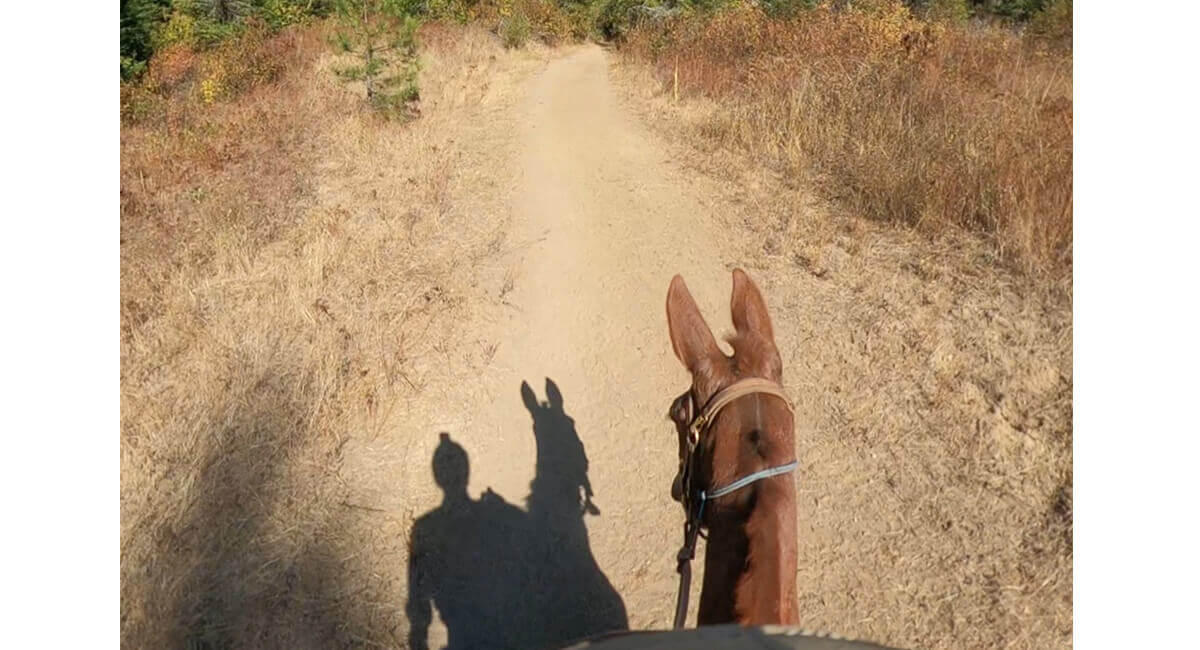Prepare with a Pre-ride Checklist and Practiced Training
We’ve all been there: headed down the trail and our mount suddenly decides to exit the area, posthaste. How we respond to that event determines whether the ride is over or if it’s no big deal.
My bestest boy mule, Ruger, encountered a mule-eating stump on a recent trail ride. Now I’d love to think that Ruger was doing his level best to protect both of us from the imminent danger that waits within a stump. It’s similar to the dangers lurking in plastic bags, round bales, and mule-eating bears disguised as tiny white dogs. Unfortunately, that’s not the case.
Why Spooks Happen
Horses and mules are prey animals with an instinct to look for potential danger and flee when they find it. This “fright and flight” response has kept equines of all flavors alive for millennia. Horses evolved in wide open spaces where animals that ran first and thought about it later lived long enough to reproduce and reinforce that behavior.
One of the many reasons I’m partial to mules is that donkeys have less of a flight response than horses. Of course, you’ll have to figure out which half (horse or donkey) you’re riding that day.
While these historical facts are interesting, I would argue that knowing the root cause of the spook doesn’t make riding one out any easier. Ruger certainly listened to his horse side when we encountered the terrifying stump and the tiny white bear.
Before the Spook
I’m a big fan of proactively controlling spooks. I think of every ride as an airplane flight where I’m the pilot. Preflight checks work for aviators and horsemen; they’ll save you from an accident. We can learn a lot about what kind of day our animals are having if we take the time to look and listen before we head down the trail. Ty Evans taught me an excellent pre-ride checklist I run through before every ride.
Pre-Ride Checklist
• Stand still to mount
• Lateral neck flexions
• Move the hindquarters and shoulders (clear the fronts)
• On course/loose rein circles
• Roll the hinds and return to the circle
If we can’t complete these few simple items before we head out on the trail, it may be time to change our plans and work out whatever kinks are in the system while we’re still in a relatively safe area and not on a narrow mountain trail. Forging ahead without a solid handle is a sure route to an eventful ride.
Listening to our Animals Doesn’t Stop at the Trailhead
During a ride, watch for potential monsters that might spook your horse. I watch for pricked ears pointing at something of interest. Sometimes I can find the beast; usually, I can’t. To be honest, my seeing the monster is irrelevant. I don’t have the same perspective as my animal. Whether I understand or not, whatever he’s experiencing is very real to him.
When I notice any indication of Ruger becoming overly concerned, I put him to work. I’ll run through that checklist and give him something else to think about besides the monster. Once he’s relaxed and listening again, we’ll continue down the trail.
The One-rein Stop
After two-and-a-half decades in the saddle, I’ve determined the following: most people will wait until the horse is in a full-out run before they decide to do something. By then, it’s too late. Worse, after the dust has settled, they blame the one-rein stop for the wreck. You must train and prepare yourself to react as soon as the beast wants to take off, not once the critter hits 100 miles an hour.
For the one-rein stop to work, it must be an ingrained habit that is practiced and refined regularly. It is an area where simply knowing the theory won’t do. To me, the one-rein stop is a fundamental tool everyone should have on their horse. Horses need to learn this emergency brake before being ridden outside the arena, and it can be a lifesaver.
A side benefit of practicing the one-rein stop is that when a spook does occur, you’ll be better prepared to sit deep and stay somewhat more relaxed instead of getting tight and hauling back on both reins—each of which only serves to make a bad situation worse.
Thank You for the Opportunity
After the spook has occurred and you’ve put the one-rein stop to work, it’s time to address whatever monster you’ve encountered. You’ve been gifted a fabulous training opportunity; be sure to take advantage of it.
Early in my riding career, I would have pointed my horse at the scary monster and tried to convince him—with lots of pats and consoling talk—that it was ok and that all would be well. I don’t think this approach worked then, and I don’t believe it works now.
Here’s a better system that works for me. Once you’re back in control of the situation, put the horse’s feet to work. Using one rein, bend him. It’s much harder for a horse to return to the reactive side of his brain when he’s redirecting his feet. If you’re in a safe area, go back to Ty’s checklist; flex his head, move the hinds, and clear the fronts.
Please spend a few minutes getting your equine soft and relaxed again before you continue the ride. This will be time well spent, help bring him back to focus, and help ease your nerves. Be patient; after all, you’ve just avoided a dangerous stump full of gremlins.
As horse and mule owners, we’re responsible for guiding and protecting our mounts. When our animals get scared, it’s our job to give them guidance to keep them safe.
For more information on trail riding and horse camping, visit www.TrailMeister.com. TrailMeister is the world’s most extensive guide to horse trails and camps and a resource for information to keep your rides enjoyable and safe. The best-selling book The ABCs of Trail Riding and Horse Camping covers tips ranging from how to train your horse for the trail to how to use a GPS. Get your copy on Amazon.
See this article in the June 2024 online edition:
June 2024

Robert Eversole, ”the trail meister,” owns www.TrailMeister.com, the largest database of horse riding and camping areas in the U.S. with free trail and trailhead information, trail maps, and much more to help horse enthusiasts experience the joys of trail riding. Robert is a registered riding instructor with PATH International, a mounted search and rescue team member, and a U.S. Marine who has served on the board of the Backcountry Horsemen of Washington (BCHW). He is enjoying his new career helping fellow trail riders stay found and safe on the trail. When not on the trail, The Trail Meister resides near Spokane, WA and teaches land navigation to a wide variety of outdoor groups across the nation. For North America’s largest horse trail and camping directory, trail tips, and more, visit www.TrailMeister.com.





